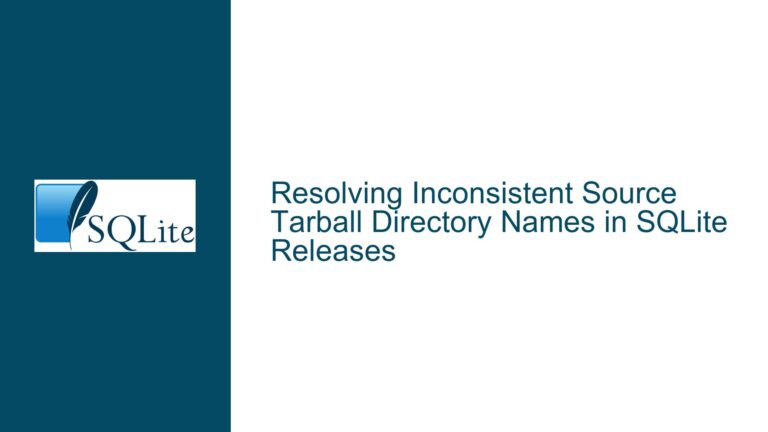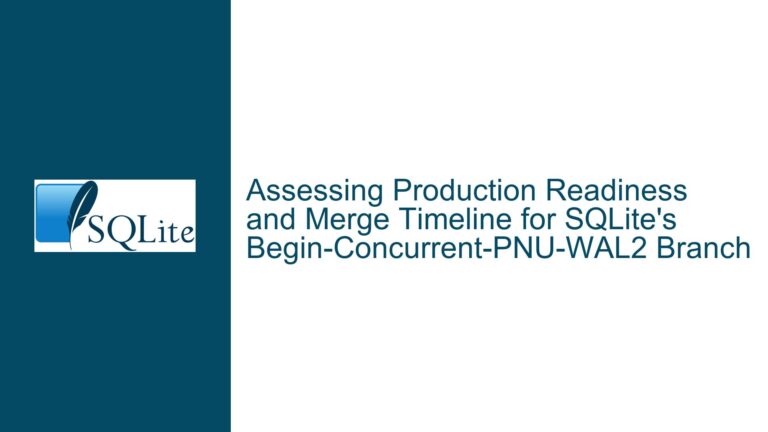Integer Overflow Vulnerability in SQLite’s setupLookaside Function
Integer Overflow in Memory Allocation Calculation
The core issue revolves around an integer overflow vulnerability in the setupLookaside function within SQLite’s source code. This function is responsible for dividing a pre-allocated memory buffer into smaller chunks, referred to as "lookaside" memory blocks, which are used to optimize memory allocation for small, frequently used objects. The function takes two user-defined parameters, sz and cnt, which represent the size of each lookaside buffer block and the number of such blocks, respectively. The function then calculates how many large (nBig) and small (nSm) memory blocks can be allocated from the total memory pool (szAlloc).
The vulnerability arises during the calculation of nSm, the number of small memory blocks. Specifically, the expression (szAlloc - sz * nBig) / LOOKASIDE_SMALL does not account for the possibility of an integer overflow when multiplying sz by nBig. This oversight can lead to incorrect memory allocation, potentially causing crashes or exploitable memory corruption.
Detailed Breakdown of the Issue
The setupLookaside function begins by calculating the total memory to be allocated (szAlloc) using the expression sz * (sqlite3_int64)cnt. This calculation is correctly cast to sqlite3_int64 to prevent overflow. However, the subsequent calculation of nSm does not apply the same precaution. When sz and cnt are large enough, the multiplication sz * nBig can exceed the maximum value that can be stored in a standard integer, leading to an overflow. For example, if sz = 320 and cnt = 10,000,000, the product sz * nBig becomes 320 * 7,142,857, which exceeds the maximum value for a 32-bit integer.
The overflow results in an incorrect value for nSm, which is then used to allocate memory. This can lead to several issues, including:
- Incorrect Memory Allocation: The calculated number of small memory blocks (
nSm) may be significantly larger or smaller than intended, leading to either insufficient memory allocation or excessive memory usage. - Memory Corruption: If the overflow causes
nSmto be too large, the function may attempt to allocate more memory than is available, potentially overwriting adjacent memory regions. - Security Vulnerabilities: In the worst-case scenario, an attacker could exploit this vulnerability to execute arbitrary code by carefully crafting the values of
szandcntto trigger the overflow and manipulate memory allocation.
Example Scenario
Consider the following example with sz = 320 and cnt = 10,000,000:
- The total memory allocation (
szAlloc) is calculated as320 * 10,000,000 = 3,200,000,000, which is correctly stored as asqlite3_int64. - The number of large memory blocks (
nBig) is calculated as3,200,000,000 / (128 + 320) = 7,142,857. - The number of small memory blocks (
nSm) is calculated as(3,200,000,000 - 320 * 7,142,857) / 128. However, due to the overflow in320 * 7,142,857, the result is40,697,289instead of the expected7,142,857.
This incorrect value for nSm leads to a significant discrepancy in memory allocation, potentially causing the issues outlined above.
Interrupted Write Operations Leading to Index Corruption
The integer overflow vulnerability in the setupLookaside function can have far-reaching consequences, particularly in scenarios where the database is under heavy load or operating in a constrained environment. One of the most critical impacts is the potential for interrupted write operations, which can lead to index corruption and other forms of data inconsistency.
Impact on Write Operations
When the setupLookaside function incorrectly calculates the number of small memory blocks, it may allocate insufficient memory for the database’s internal structures. This can cause write operations to fail or be interrupted, particularly if the database engine attempts to allocate more memory than is available. In such cases, the database may be left in an inconsistent state, with partially written data or corrupted indexes.
For example, if the database is in the middle of a transaction and the setupLookaside function fails to allocate the necessary memory, the transaction may be aborted, leaving the database in an inconsistent state. This can lead to data loss or corruption, particularly if the transaction involved multiple related operations.
Impact on Indexes
Indexes are particularly vulnerable to corruption in the event of interrupted write operations. When an index is updated, the database engine typically allocates memory for the new index entries. If the setupLookaside function fails to allocate the necessary memory, the index update may be incomplete, leading to a corrupted index. This can result in queries returning incorrect results or failing altogether.
In addition, corrupted indexes can exacerbate the problem by causing further memory allocation issues. For example, if a query attempts to use a corrupted index, the database engine may allocate additional memory to handle the query, potentially leading to further memory allocation failures and additional corruption.
Impact on Database Recovery
In the event of a crash or power failure, the database engine relies on its internal structures to recover and restore the database to a consistent state. However, if the setupLookaside function has caused memory allocation issues, the database may be unable to recover properly, leading to data loss or corruption.
For example, if the database engine attempts to recover from a crash and encounters a corrupted index, it may be unable to reconstruct the index, leading to permanent data loss. In addition, the recovery process itself may fail if the database engine is unable to allocate the necessary memory, leaving the database in an unrecoverable state.
Implementing PRAGMA journal_mode and Database Backup
To mitigate the risks associated with the integer overflow vulnerability in the setupLookaside function, it is essential to implement robust safeguards and best practices. Two key strategies are the use of the PRAGMA journal_mode directive and regular database backups.
PRAGMA journal_mode
The PRAGMA journal_mode directive controls how SQLite handles its journal file, which is used to ensure atomic transactions and recover from crashes. By setting the journal mode to WAL (Write-Ahead Logging), you can significantly reduce the risk of data corruption in the event of a crash or power failure.
How WAL Mode Works
In WAL mode, SQLite writes changes to a separate WAL file instead of directly modifying the database file. This allows multiple readers to access the database simultaneously while a single writer makes changes. In the event of a crash, SQLite can use the WAL file to recover the database to a consistent state.
Benefits of WAL Mode
- Improved Concurrency: WAL mode allows multiple readers to access the database simultaneously, improving performance in multi-threaded applications.
- Reduced Risk of Corruption: By writing changes to a separate file, WAL mode reduces the risk of data corruption in the event of a crash or power failure.
- Faster Recovery: In the event of a crash, SQLite can recover the database more quickly using the WAL file.
Setting WAL Mode
To enable WAL mode, execute the following SQL command:
PRAGMA journal_mode=WAL;
Database Backup
Regular database backups are essential for protecting against data loss and corruption. In the event of a catastrophic failure, a recent backup can be used to restore the database to a consistent state.
Backup Strategies
- Full Backups: A full backup involves copying the entire database file to a separate location. This is the most straightforward backup strategy but can be time-consuming for large databases.
- Incremental Backups: Incremental backups involve copying only the changes made since the last backup. This can be more efficient for large databases but requires a more complex backup process.
- Automated Backups: Automated backup solutions can schedule and manage backups on a regular basis, ensuring that backups are always up-to-date.
Implementing Backups
To implement a backup strategy, you can use SQLite’s built-in backup API or a third-party tool. The backup API allows you to create a backup of the database while it is in use, ensuring that the backup is consistent.
Combining PRAGMA journal_mode and Backups
By combining WAL mode with regular backups, you can create a robust defense against data corruption and loss. WAL mode reduces the risk of corruption during normal operation, while backups provide a safety net in the event of a catastrophic failure.
Example Workflow
- Enable WAL Mode: Set the journal mode to WAL to improve concurrency and reduce the risk of corruption.
- Schedule Regular Backups: Use an automated backup solution to create regular backups of the database.
- Monitor for Issues: Regularly monitor the database for signs of corruption or other issues, and take corrective action as needed.
Conclusion
The integer overflow vulnerability in SQLite’s setupLookaside function is a serious issue that can lead to memory corruption, crashes, and potential security vulnerabilities. By understanding the root cause of the issue and implementing robust safeguards such as WAL mode and regular backups, you can mitigate the risks and ensure the stability and integrity of your database.






